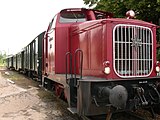Hespertalbahn | |||||||||||||||||||||||||||||||||||||||||||||||||||||||||||||||||||||||||||||||||||||||||||||||||||||||||||||||||||||||||||||||||||||
|---|---|---|---|---|---|---|---|---|---|---|---|---|---|---|---|---|---|---|---|---|---|---|---|---|---|---|---|---|---|---|---|---|---|---|---|---|---|---|---|---|---|---|---|---|---|---|---|---|---|---|---|---|---|---|---|---|---|---|---|---|---|---|---|---|---|---|---|---|---|---|---|---|---|---|---|---|---|---|---|---|---|---|---|---|---|---|---|---|---|---|---|---|---|---|---|---|---|---|---|---|---|---|---|---|---|---|---|---|---|---|---|---|---|---|---|---|---|---|---|---|---|---|---|---|---|---|---|---|---|---|---|---|---|
| |||||||||||||||||||||||||||||||||||||||||||||||||||||||||||||||||||||||||||||||||||||||||||||||||||||||||||||||||||||||||||||||||||||
The Hesper Valley Railway (German: Hespertalbahn) is a German heritage line running steam locomotive services between Kupferdreh Old Station and Haus Scheppen on the Baldeneysee lake in Essen.
Contents

As a narrow gauge wagonway it linked opened up Erzgruben in 1867, and the Pörtingsiepen mine in 1877. The upgrading of part of the line to standard gauge followed in 1918. In 1973 the line was closed. In June 1975 the Hesper Valley Railway Preservation Society (Verein zur Erhaltung der Hespertalbahn) saved the route and has since operated it as a heritage railway. The top speed on the line is 15 km/h.
The Hesper Valley Railway is part of the Route der Industriekultur , route 12 (The Ruhr — past and present) and route 15 (Railways in the area).

